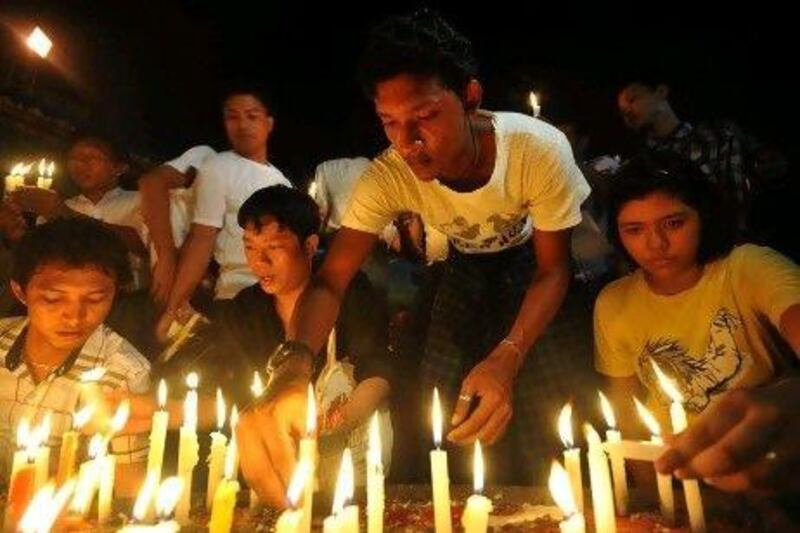YANGON // Thousands have protested in Myanmar this week in the biggest test yet of the government's commitment to reform.
Demonstrations over electricity shortages began in Mandarlay on Sunday and quickly spread to several towns and cities.
On Wednesday, hundreds of protesters in Yangon carried candles to the Shwedagon Pagoda, the Buddhist shrine that has often been a focal point of dissent.
They are the largest demonstrations in Myanmar since the 2007 "Saffron Revolution", when anger over rising prices spiralled into broader protests against the military regime, and were eventually put down with lethal force.
But things have changed in Myanmar since then. The new, nominally civilian government under the reformist president Thein Sein, which came to power last March, appears determined to show that decades of political oppression are over.
"We are expecting the demonstrations to continue," said Moe Thway, an activist with a group called Generation Wave in Yangon.
There have been scattered reports of arrests throughout the week, including members of the National League for Democracy led by Aung San Suu Kyi.
Several demonstrators were beaten and six people were taken away by police for questioning yesterday, said a protest leader, Kyaw Swein, in a town called Pyay, about 300 kilometres north of Yangon. "Our whole town is in trouble because of the lack of electricity. That's why we decided to protest. We are just asking for our rights."
Yet the government is keen to avoid any moves that might jeopardise its warming relations with the international community.
A police official in Yangon expressed surprise at the beatings, adding there had been no wider order to clamp down on the rallies. "We have no instruction to arrest or beat the protesters. I have no idea why it happened," he said. Just last week, the US announced that it was suspending most economic sanctions against the country and appointing its first ambassador to Myanmar in 22 years in recognition of the steps taken towards reform.
"I think we will see the government take rapid action to address the concerns of the demonstrators," said Mark Farmener, the director of Burma Campaign UK, based in London. "Thein Sein doesn't want anything that can destabilise the country and strengthen hardliners in the government [who oppose reforms]."
Electricity shortages are a major problem for Myanmar, where only 25 per cent of the country has access to the national power grid.
The government has promised emergency measures. These are still uncertain times for activists in Myanmar as they try to gauge how far they can push the new government without provoking a crackdown.
Workers are also testing the waters, with factories experiencing unprecedented labour troubles in recent months.
The High-Art wig factory on the outskirts of Yangon is one of about 10 firms in the city's industrial zones experiencing strikes over pay and conditions.
Its 2,000 employees - almost all women - live in squalid barracks provided by the company and receive just 30,500 kyat per month (Dh130), rising to 70,000 kyat for those who have spent several years at the factory.
"We have no health cover - if we miss a day's work, they take 8,000 kyat out of our pay," said Ei Ei Htwe, a 23-year-old worker at the factory. "There is no clean water. The food is like prison food - dirty vegetables with insects in it."
Almost the entire workforce gathered at a government labour office earlier this month to demand better conditions.
"In the past, our complaints would disappear," said Ms Htwe. "But now there are political changes. We hope there will be a better situation."
Despite the miserable conditions, Ms Htwe said she is fortunate to have any job at all. She fled with her parents from the rural poverty of central Myanmar several years ago, and it was only through a family connection that she landed a job at the High-Art wig factory.
Myanmar has a reputation for some of the worst working conditions in the world, driven down by the lack of job opportunities in an economy crippled by international sanctions and government neglect.
But protesters now are armed with a new labour law that came into force at the end of last year, and promises to revolutionise working conditions.
"It is surprising that they introduced this reform so quickly," said Sumana Rajaratnam, an Asia analyst with the Economist Intelligence Unit who recently co-authored a report on Myanmar's new business environment.
"The new labour law allows for the right to unionise and gives a lot of assurances about the general welfare of workers. The letter of the law is very encouraging, though of course, the real question is how well it is enforced and supervised."
But as with the electricity protests this week, the government's desire for stability could work in the factory workers' favour.
"There were labour protests last year and the government strong-armed factory owners into meeting demands," said Mr Farmener. "They want to keep a lid on protests and end them as quickly as possible."
[ foreign.desk@thenational.ae ]
Follow
The National
on
[ @TheNationalUAE ]
& Eric Randolph on
[ @EricWRandolph ]
* With additional reporting by Agence France-Presse





